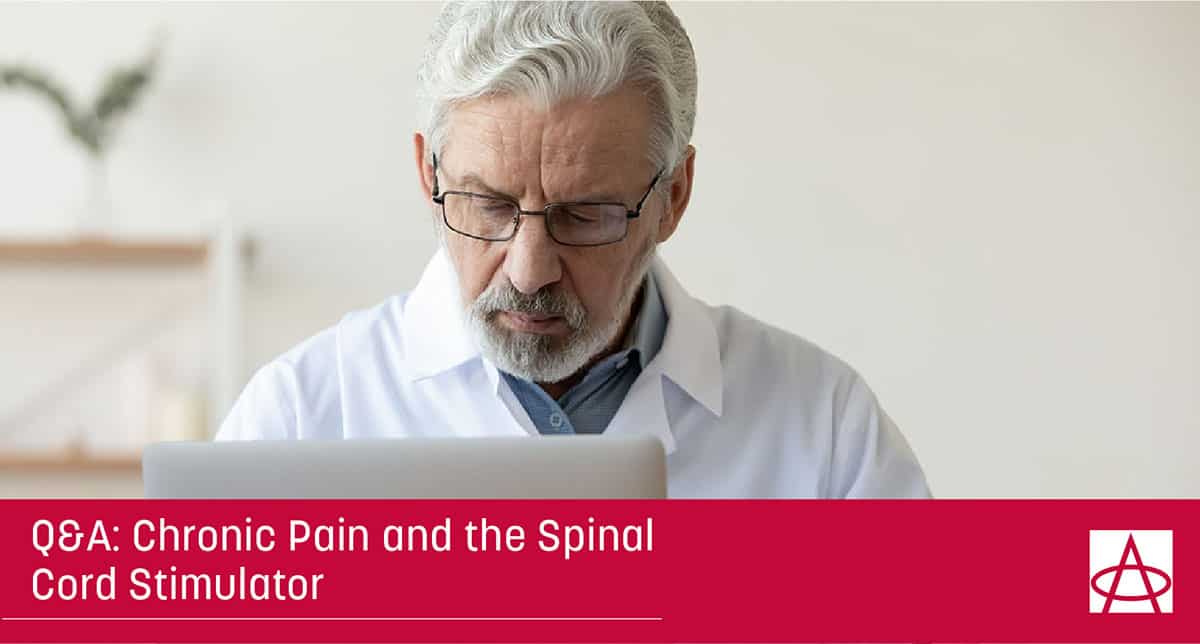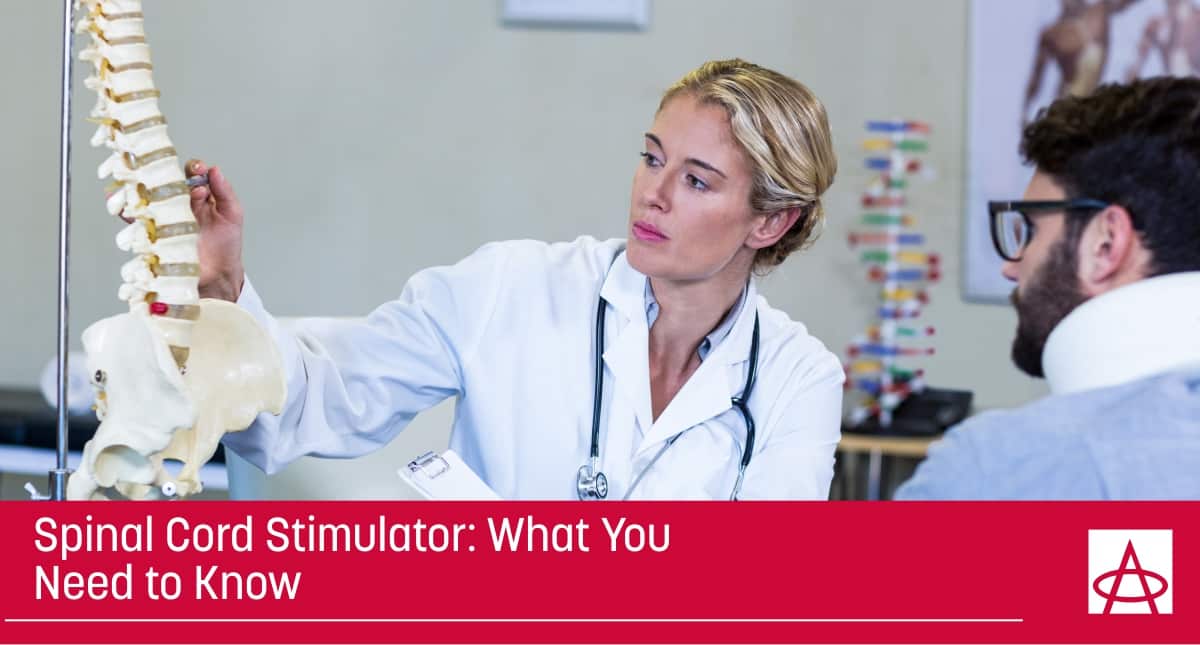
Q&A: Chronic Pain and the Spinal Cord Stimulator
By Amber Featherston, Director of Surgical Services
In APC’s recent Facebook Live lunch, we had over 300 comments asking Dr. Mark Malone, Dr. Brad Culling, and Patient Ambassador Chester Jones a variety of questions about the spinal cord stimulator. (If you missed it, you can watch the full video on our YouTube channel.)
With such enthusiastic participation, we couldn’t answer all of your questions in that session, so we’ve answered them below. We also encourage you to set up an appointment so we can address questions that are unique to your personal situation.
If you’d like to read more about the spinal cord stimulator — how it works, and what the procedure and recovery are like — you can read some of our spinal cord stimulator blog posts, which include patient testimonials.
A Stimulator for Your Pain Points
Q: Is a stimulator only good for back pain, or can it help with other parts of the body?
A: It can help alleviate pain any place on the body, we just change the placement to target different body parts.
Q: Does it help with diabetic nerve pain, migraines, occipital neuralgia, and CRPS?
A: Yes. And to address complex regional pain syndrome (CRPS), there is a specialized system called dorsal root ganglion (DRG) stimulation.
Q: Can it help with diabetic peripheral neuropathy or neuropathy due to vascular disease?
Yes, in fact more studies are currently underway due to its success in these areas.
Identifying a Spinal Cord Stimulator Candidate
Q: How do I become an APC patient? Do I need a referral? How long should I plan to wait for an appointment?
A: The first step is to call us (512-244-4272) to determine whether your insurance requires a referral. To make an appointment, you can call us or use our online patient portal. We pride ourselves on offering same-day appointments.
Q: What qualifies me as a patient who is eligible for the stimulator?
A: The first step is making an appointment and speaking to your provider. A physical exam and review of imaging (e.g., x-rays) will help determine your eligibility. The stimulator is a non-invasive therapy option, so no special preparation is needed.
Q: Are there any restrictions on who can get a stimulator (e.g, age, pregnancy, prior surgeries)?
A: There are no age restrictions. You can have a stimulator while pregnant. You don’t have to pursue other surgeries before trying the stimulator. If you’ve already had a fusion procedure, that is an indication for a stimulator.
Q: Are injections a required treatment before proceeding to a stimulator?
A: Insurance companies like to see conservative therapy, and injections fall into that category.
The Stimulator Costs
Q: Does insurance cover the stimulator? Can I find out how much it will cost me before scheduling the procedure?
A: Most insurance companies love this procedure since it provides more cost savings than long-term opioids for patients. We can connect you to our team of financial counselors to discuss your options before you schedule the procedure.
The Stimulator Procedure
Q: Is this a safe procedure to undergo during the pandemic?
A: Yes. We resumed performing the stimulator procedure after Governor Greg Abbott lifted the ban on elective procedures in April. We’ve had zero exposure reported — meaning no one on our staff has been exposed to COVID-19 — and we remain diligent about our screening processes. Your safety remains our top priority.
Q: Where can I have this procedure?
A: We currently have surgery centers in Round Rock and Amarillo, Texas. You can view all of our office locations here.
Q: What doctors do this procedure? Is it an outpatient procedure? How long does it take?
A: Interventional pain management doctors are the primary performers of this procedure, followed by neurosurgeons. Unless there are extenuating circumstances that require you to be in a hospital for this procedure, it’s typically done in an outpatient Ambulatory Surgery Center. If you’re getting a trial stimulator, the procedure will last about 30 minutes. The final implant procedure lasts one hour.
Q: What steps are necessary to get a permanent placement?
A: After you experience a successful trial, we can proceed with the implant.
Q: How big are the incisions?
A: It depends on your surgeon but most incisions are less than one inch.
Q: How long does it take to find the best pattern?
A: Finding the best pattern depends on the patient. A key driver is your body’s response to the procedure (i.e., fluid, inflammation, etc.). You could leave the day of your implant and not need any reprogramming. Or, you could be someone who needs some frequent tuning until you find optimal coverage.
Q: Can someone walk me through this process?
A: Yes! We have a team of Clinical Navigators that walk you through the whole process.
Related: How an APC Patient Found Pain Relief with the Spinal Cord Stimulator
APC’s Clinical Navigator Team
Q: What is the purpose of the Clinical Navigator team?
A: APC’s Clinical Navigator team takes care of you throughout your pain care journey. From the time you’re identified as a stimulator candidate, through your implant procedure, to your post-procedure recovery, we are a long-term support system for you.
Q: What types of pain care professionals are on the team?
A: The whole office is there to help you, including the folks at the front desk and behind the scenes taking care of your authorizations. Our Clinical Navigators oversee the whole process for you and make sure nothing gets missed, so you don’t have to worry about overlooking anything.
Stimulator Recovery & Long Term Care
Q: How long is the healing process? What’s the success rate for chronic pain patients?
A: The healing process depends on the patient. Scar tissue starts to form internally around day 14. Ninety percent of our patients have a successful stimulator trial.
Q: How long will the stimulator last? Does it ever have to be replaced? If so, how often?
A: There are many types of systems on the market for different needs. The leads can last as long as no problem is identified. The battery life ranges from 4 to 10 years, so typically we just replace the battery.
Q: What do you do if the leads are out of line?
A: We get an x-ray to confirm the leads’ alignment. Sometimes we can still achieve pain coverage without moving them. Other times the leads might need to be replaced in order for adequate therapy to be restored.
Q: What if my stimulator stops covering my area of pain? How often do you recommend reprogramming?
A: Sometimes the issue isn’t that the stimulator has stopped working, but rather that you’ve developed some new pain sources. That’s why reprogramming might be necessary, which you can schedule as often as needed.
Q: What if you’ve had the stimulator a long time, have scar tissue, and need it removed?
A: Due to the non-invasiveness of the procedure, the stimulator is completely removable.
Your Post-Stimulator Lifestyle
Q: Will I feel the implant?
A: Most people forget it’s there.
Q: Will this help in reducing my daily pain meds?
A: The goal is to improve your quality of life. If reducing your pain meds is part of that goal, then absolutely.
Q: Can I still get other procedures after I have the implant? Are the stimulators MRI compatible?
A: There can be many sources of pain, so other procedures might be part of your plan of care. There are MRI- compatible stimulators, so if you anticipate needing one let us know.
Q: Are there things I can’t do with a stimulator?
A: No, the whole point is to get you back to a functional lifestyle.
Q: Can I go swimming, diving, running, golfing, and/or use a hot tub?
A: You can absolutely swim, dive, run, and golf. You can use a hot tub after you have been released by your provider.
Q: Can I fly or enter a building with a metal detector?
A: Yes, you can fly. Stimulators are not known to set-off metal detectors. But in the event you need it, you will also have an official implant card from the manufacturer.
Q: Will it interfere with a pacemaker?
A: No, they rely on different frequencies.
Q: Is this device connect via bluetooth?
A: Some stimulators have bluetooth capabilities.
Additional Questions
Q: If I’m having neck and back pain, can more than one stimulator be implanted? Is there a stimulator that covers both?
A: Many people suffering from chronic neck and back pain have two stimulators because there is no single stimulator designed to cover both effectively.
Q: How is the stimulator different from a TENS unit?
A: A transcutaneous electrical nerve stimulation (TENS) unit is different in that it is an external device that is used for muscles.
Q: What is the difference between an electrode and a paddle lead stimulus?
A: The difference is in who performs the procedure and how the lead is secured.
Q: Can I have a pain pump and stimulator at the same time?
A: Yes, although it’s uncommon.
Q: What stimulator vendor do you recommend?
A: There are many great vendors on the market. The market leaders are Abbott, Boston, and Medtronic.
Are you ready to take the first step towards lasting pain relief? Contact us to set-up your appointment today.
And be sure to follow us on Facebook so you can join us at our next live streaming event.






